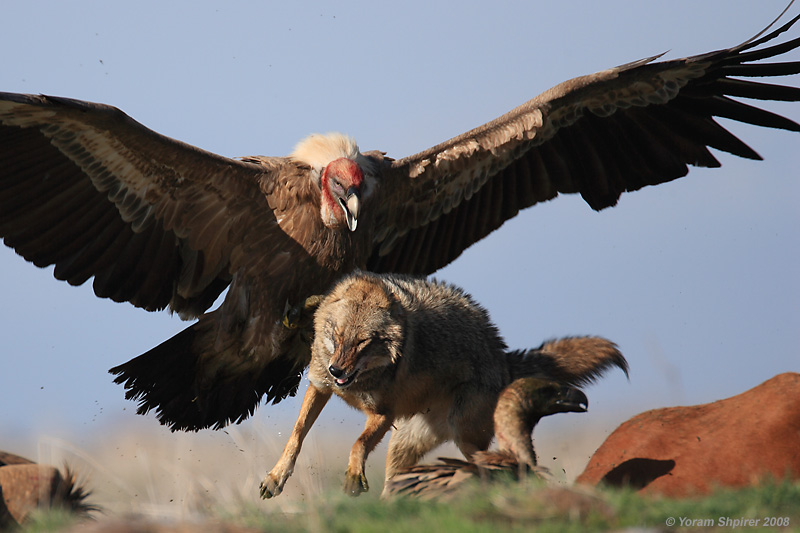Bone Dropping Bearded Vultures
Biology 342 Fall 2012
Ivy Hellickson
Adaptive Value
It's apparent that a lot of effort is required to eat bones, so why would an animal evolve such a bizzare diet? Feeding primarily on bones has apparent advantages. For one, having bone function as the major dietary component minimizes competition. Bearded Vultures are smaller and less aggressive than many of the other scavengers, such as Griffon Vultures and Jackals that share the same habitat. However, none of these birds fit into the bone-eating niche that the Bearded Vulture occupies. Therefore, the bearded vulture has access to a food source that is mostly untapped by the other scavengers [9].

Figure 12. A Griffon Vulture competing with a jackal for access to a carcass [21].
Eating bones also allows the vulture to have a food source even in a period of food scarcity. When a carcass is seemingly so decomposed that there is nothing edible left, the bones remain. Fig 13 and fig 14 below show that in both summer and winter, there are more bones available than there is meat [23]. The bones contain nutritious marrow, which provides especially good benefits during the colder months when food is even harder to find. It has been observed Bearded Vultures sometimes adopt a wider variety of prey items during the summer, but rely on the bones during the winter [12].
Figure 13. The difference between the biomass and the energy requirements of the current bird scavenger polulation (expressed in calories per km2) in the ecosystem for the summer season. The x-axis is in by municipalities that are in Catalonia, Northern Spain. Each bar represents on of the four scenarios of food availability being considered (100%, 50%, 25% and 0% of food provided by domestic ungulates). Relevant to adaptive value, it should be noted that there is a general abundance of bone compared to meat during the summer season [22].
Figure 14. The diifference between the biomass and the energy requirements of the current bird scavenger polulation (expressed in calories per km2) in the ecosystem for the winter season. The x-axis is sectioned by municipalities that are in Catalonia, Northern Spain. Each bar represents on of the four scenarios of food availability being considered (100%, 50%, 25% and 0% of food provided by domestic ungulates). Relevant to adaptive value, it should be noted that there is a general abundance of bone compared to meat during the summer season [22].
So the bone diet obviously has advantages, but what about the crazy bone-dropping method of cracking the bones? The behavior of bone dropping itself has an adaptive value that is directly connected to the benefit of the diet itself. Because of the advantages already mentioneda at the top of the page, the bird probably gained benefits from the diet first and then this benefit was increased by dropping and breaking larger bones, allowing the vultures to access even more of the nutrition that is otherwise out of reach to other scavengers.